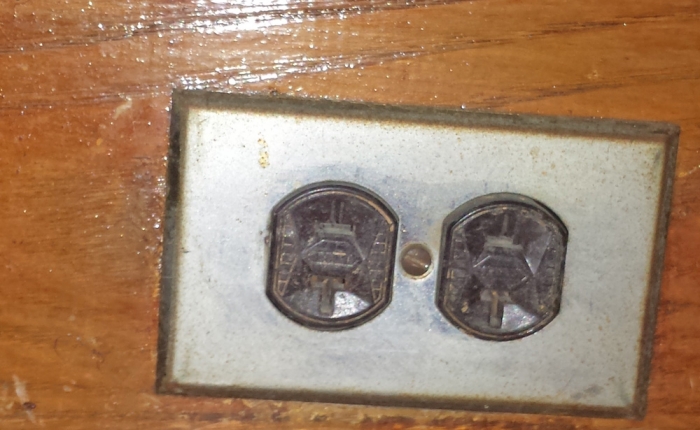Electric Outlets in house: DIY or hire someone?
In general, it's a pretty easy swap. That said, some old houses in the area can have pretty funky wiring. If you know that it's the actual outlet, then switching it out isn't that complicated. My one recommendation is to invest in a good voltage tester to make sure power is turned off to the outlet when you turn off the circuit breaker or pull the fuse.
But if you even suspect it might be the wiring, I think you're better off having an electrician handle it.
Switching out outlets isn't at it's core difficult. You're basically just screwing things off and back on.
Where you can run into problems is that if the cables are really old, the insulation on them can start to crumble. If the wires in your walls look anything like what you see in the picture you're lucky.
Also, the color coding wasn't terribly standard back in the days, so it helps to take pictures and label things based off of what you find before you start replacing things.
And if anything gets beyond the norm, be prepared to back out and call an electrician. It's not worth killing yourself and/or burning down the house to save 'a few bucks'.
And in line with what Particle Man said, if you're not 100% sure there's no electricity in an outlet then stay away. Don't assume that because all of other lights outlets in a room/floor are out that the outlet you're working on means that one is out too. In between the time the house was built people did all sort of strange nonsense. My house has one outlet in the master bedroom and everything in the attic wired up to the (mostly) ceiling circuit from the first floor. Annoying!
You might want to consider that if you're going down this road that you might also want to add out lets in some of the rooms. While I would swap out an outlet without giving it too much thought (assuming that the wiring is solid), I don't know that I would add outlets on my own.
The photo below represents an idea of what I have. it's an old 2 prong outlet. some of the outlets are REALLY old they have some old prong outlets that i can't even use. I'd like to swap out what I can and use newer outlets. I'm not necessarily having problems with the wires, i just need to swap out the outlets.
see photo below
This is NOT a place I would start my DIY career. I'd get someone experienced and willing to teach... to do just that teach you how.
Another issue you'll run into is grounding. If you're replacing two pronged (and possibly ungrounded) outlets with three pronged outlets, you need to either ground the outlet somehow or install a GFCI in the circuit somewhere.
But now we're treading into the limits of my DIYer knowledge. It may not be that difficult, but it's very possible that an electrician would be better.
Call an electrician. Those two prong outlets are not grounded. You want to put in properly grounded three prong outlets and that's not a DIY thing unless you're experienced.
Get yourself a good diy book on electric work. If the box is metal and the wire is bx (metal sheathed) the box can serve as the ground. A good voltage tester will tell you if the box is grounded or not, so it may be just simple to unscrew and reconnect the 2 wires hot and neutra
Do you have an electrician? Everyone needs an electrician, a plumber, a roofer, and a tree company (for starters). Too many people wait until they have an emergency, then frantically post on MOL and call around and use the first guy who's available.
I think it's important to establish relationships with tradesmen on minor, non-emergency jobs right after buying a house. You can decide if you like and/or trust them, then, when you do have an emergency, you have someone to call and they are more likely to respond and be available since you're an existing customer.
Maybe have an electrician replace the outlets in one room. Watch closely and ask lots of questions. After he's done, you have an electrician on staff, you've had your wiring checked out, and you've learned how to replace an outlet from a professional. Well worth a couple hundred bucks, in my opinion.
Do a little more investigation. Take a cover off and loosen the two screws holding the receptacle into the box. Are the wires cloth covered, and brittle? I've done a lot of these around here and problems definately do come up. The non-grounded to grounded issue is easy to overcome and should not be a decision factor one way or the other.
"Our house is old. Most of the outlets are old, some can't be used and the others are "loose". Basically outlets need to be switched out.
I have no experience with electric work around the house...."
Old houses have cloth insulated wiring that's falling apart. They also have metal conductors that are oxidizing and often snap at the junction of other old wires.
Finally, it is often difficult to tell a neutral from a hot wire.
If you feel comfortable working with these, then go for it.
If not, hire an electrician. It will be money well spent.
PrettyHandyGirl's house has modern wiring and is pretty simple and easy to work with.
Your house's wiring looks like it was put in during the same era as my houses.
The wire is a solid core with rubber insulation and a colored tread weave on top to protect he rubber, and and armored(metal) jacket to protect the whole thing. Black string for hot and White string for the neutral. Problem is the black has faded to grey from age , and the white has also turned to grey from age. Making them almost indistinguishable. But the fun doesn't end there. Because old lights work equally well with hot and neutral reversed, either the white or black could be hot depending on what happened farther up the line(closer to the fuse box).
That "bare grounding wire" in PrettyHandyGirl's picture, our era doesn't have that. If you want to have a functioning ground in the three pronged outlet, you'll have to use your outlet box, and also the armored jacket, for the ground. If there's a mismatch of cable types, or loose jacket/box connection, you won't have a ground.
It's something that can be really easy, or really difficult depending on what happened with your wiring in the past.
Fun little things I've found while putting in/fixing lights and outlets in my house. 8 hot wires wired into 3 other hot wires. Apparently there was a chandelier there with 8 lights, and that spot feed two other areas(at least) down the line. Watching 4 inches of insulation disintegrate and fall off leaving me to re-insulate wire 3 inches inside of the ceiling.
Even if you're a halfway decent DIY electrician, it makes sense to call Jim Honrath 973-494-4472. He's done work at my house and charged less than I wanted to pay him. And it's great work and he even cleans up so it's cleaner than it was to begin with.
5 years ago we paid $17.50 per outlet to have someone come in and switch out every outlet in the house. Many were old 2-prong and now all are 3-prong. Money well spent, in my eyes. We also had all switches replaced (don't know the fee, but I imagine it was similar). Having the same kind of white switches in each room made a surprising difference in the feel of the house.
While it is super easy to replace outlets and even upgrade from two to three prong outlets, i would agree that if you aren't DIY experienced, this isn't when to start. Hire someone, you could ask if you can observe, they will probably charge you extra for that service...
What almost everyone else said. Hire an electrician for this round and observe. You'll learn a lot about the state of your house and whether or not it's safe for you to start working on it yourself. If your house was newer, I'd say take a shot, but this seems a little too risky to me.
My husband does some DIY electrical work. The rule in our house is that the main breaker for the whole house is off whenever he is doing anything that involves the actual connections. (When putting in a new circuit, he pulls/mounts/etc everything first and then turns it off before connecting to the box. For fixing old stuff the main breaker goes off first.)
Echoing and building off some good advice from Particle and others- given the likely knob and tube wiring you have, I'd let a pro do it. That stuff can be fine if not disturbed, but if you're switching out outlets they're going to get disturbed. Most of that stuff went in when all they were looking to power was a few light bulbs and a radio. Modern needs are quite a bit higher.
I get a bit concerned when I see another commenter stating that they switched from 2 to 3 prong for under $20 an outlet. I suppose that could be true, but (and it's been a while) iirc you can't ground knob and tube.... But you can just stick a grounded outlet on there and just not use the ground, which to all the world would look good to go but in reality was anything but.
There are issues with insurability with knob and tube, so if you were considering ever selling now may be a good time to bite the bullet and get the bigger job done.
I would not jump to the conclusion that the house has knob and tube wiring. That isn't written anywhere in this thread. Old bx has its own issues, but it is workable.
FilmCarp said:
I would not jump to the conclusion that the house has knob and tube wiring. That isn't written anywhere in this thread. Old bx has its own issues, but it is workable.
Neither is bx, except by another speculating poster. Given the age of the housing stock and ungrounded outlets, it's likely to be one or the other, wouldn't you agree?
Either way, if the homeowner doesn't know, it might be time to bring someone in to give it a look. Maybe they can just slap some GFCI in and be done, but maybe not
Given the age of the outlet, and that its mounted in the chestnut baseboard the electrical is most Lilly bx. Given that bx in these installations is usually nailed close to the box, its next to impossible to get extra length on the wires if you come up short. These boxes are usually smaller too because there mounted in the baseboard. When I did mine, it was easier for me to run new wires, cut new holes in the walls , use new boxes and install new outlets then to fiddle around with those old wires and boxes in the baseboard.
That is what we had in our old chestnut baseboards, and other parts of the house like the attic. Much had been updated, but not all.
After we bought our 1928 house, we discovered with each new small project (adding a fixture here, needing an outlet there) that at least one previous owner was a "DIY" electrician. One of those old projects actually gave a professional electrician working here a nasty shock. And in the course of another project, the electrician came to find me: "So....when did this house have a fire?" I agree with everyone who's made this point already: you just don't know what you're going to find behind the walls of an old house. You're far better off in building a relationship with an experienced electrician who is well-acquainted with the quirks of the local housing stock.
Following on beppolina's post: our immediate previous owner was an electrical engineer and I think an inspector in another town. He had done a lot of DIY on the house. However, when I called an electrician because something *melted* in the small electric box the p.o. had installed in the attic, he said that EEs are the *worst* because they think they know. Electrician also said that the line the p.o. had run up the outside of the house to the attic "might as well have been an extension cord."
In a word, if your electric has not been updated, I would definitely get a reputable electrician in to look at it before starting on the outlets. You will be able to do plenty of "surface" work (outlets, switches, etc.) on your own once you know the stuff inside the walls is good.
Just mentioning that we have a circa-1930 house in Maplewood and have had electrical work done over the years. Some of the outlets were very poorly wired - I remember one involved a splice into a ground wire (or something like that) which was a definite fire hazard. We never would have realized there was an issue if we hadn't had an electrician in to check out another issue in that room. Some of the outlets had brittle wires that were crammed into the little metal boxes in the wall...... No way I'd try to do it myself because I wouldn't trust myself to recognize other possible problems once I got into the outlet. There were only 2 previous owners of our home, and one was an engineer! I don't know who was responsible for the problems we found, but we've swapped out many of the outlets and upgraded the electrical service in the years we've been here. (By "we" I mean we paid and a licensed electrician who knew what they were doing did the actual work.  )
)
Good luck and hope you don't find any unexpected problems!
Hey, I am big on DIY. Your project, I'd farm it out. You need some specific tools and finding a good ground is going to be a problem.
Call 908 377-7278. Plainfield Electric, (personal number for Greg the owner)
A really good guy. He and Mike can fix this for you.
Later, Da
The UPS Store George
Since it was mentioned... If I have a two prong outlet, and use a plug converter for a three prong lamp, am I supposed to do anything with the little metal hole on the converter? Should I get this outlet replaced? I use this for a lamp in my son's room overnight...
Eta- my pic isnt showing, I googled and it is called a "cheater plug"




























Our house is old. Most of the outlets are old, some can't be used and the others are "loose". Basically outlets need to be switched out.
I have no experience with electric work around the house but I'm willing to switch them out if its doable for a newbie (youtube, home depot, lowes, and this website http://www.prettyhandygirl.com/changing-out-old-ugly-outlet/ seem to think i can do it. First website i found, im sure there are tons others with photos, steps, tools to purchase/use.
If this is something that needs someone with experience then i'll take a recommendation for an electrician in the maplewood area. In my house, First floor downstairs has about 5 outlets, upstairs about 6 more (2 in each room, 3 rooms) that need to be swapped out.
Thanks for any advice